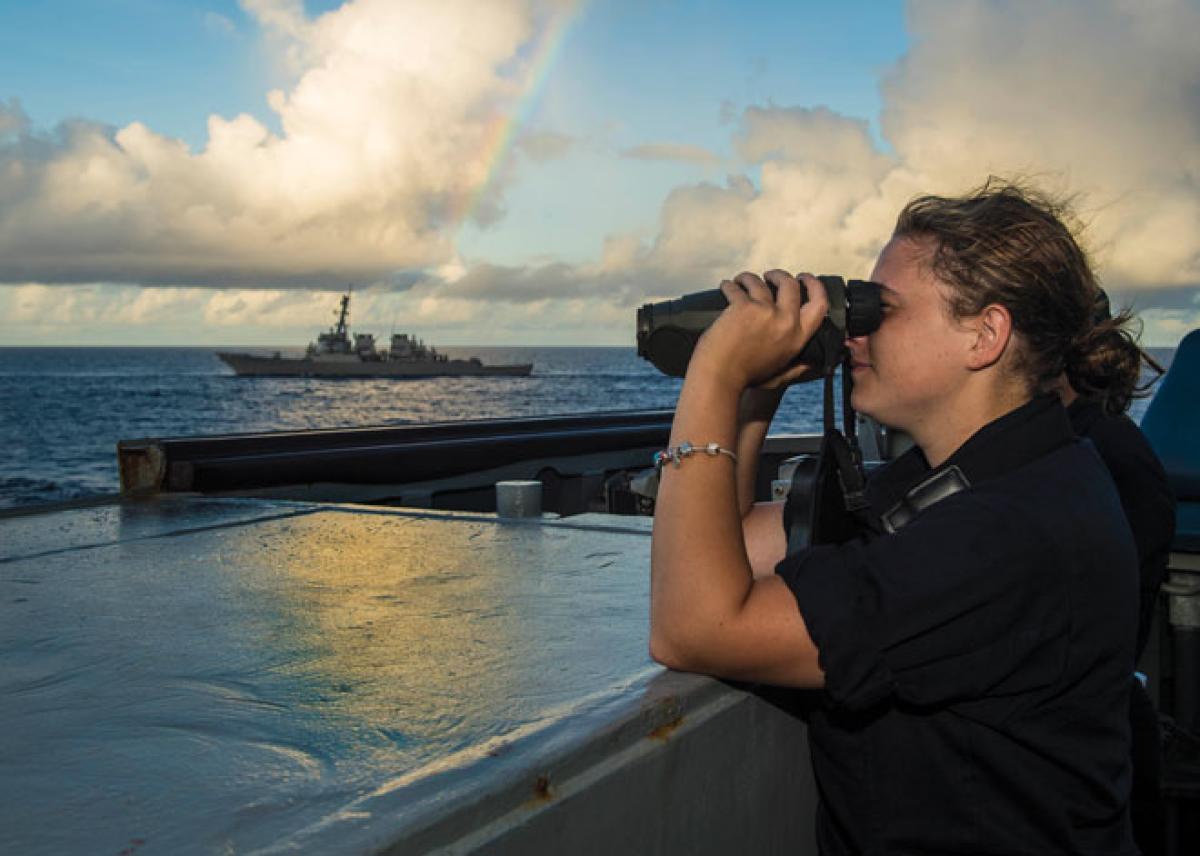Lookouts on board U.S. Navy ships are trained to report objects they see (as well as sounds heard) in a prescribed format to ensure consistency and precision (see “Bluejacket’s Manual: On the Lookout,” August, p. 6). The format for these reports is described in instructions to lookouts:
1. WHAT YOU SEE: Describe the contact quickly and briefly. Name the type or class of ship or aircraft if you recognize it; otherwise, simply report “ship,” “plane,” and so forth. If all you see is an object but cannot make out any details, report it simply as a “contact.”
2. BEARING: Always report contacts in relative bearings. These are always given as three digits, spoken digit by digit.
3. RANGE: Estimate the contact’s distance from your ship and report that in yards/miles. This is spoken digit by digit, except that multiples of hundreds and thousands are spoken as such.
4. TARGET ANGLE: Report target angle on all ships, given in three digits, spoken digit by digit.
5. POSITION ANGLE: Report position angle on all aircraft, given in one or two digits, spoken as a whole, not digit by digit.
6. MOVEMENT: Report whether the contact is moving from right to left or left to right; is opening, closing, or paralleling; is moving at high speed or slow speed; is dead in the water; and so forth.
Relative Bearings
Navigational directions are described by true bearings; 000 degrees represents true north, 090 degrees is east, 180 degrees is south, 270 degrees is west, and other directions are in between as appropriate. But, because lookouts do not always have access to a compass at their watch stations, they report objects in degrees relative to their ship (the term “ownship” is often used to distinguish one’s own ship from others being reported).
Relative bearings are similar to true bearings except they are oriented on ownship’s bow instead of true north. Therefore, 000 degrees represents dead ahead when using relative bearings. Just as true bearings progress in a clockwise direction, so do relative bearings. If a lookout wants to report a periscope that is broad on the ship’s starboard side, its relative bearing is 090 degrees; a fishing boat dead astern would be reported as 180 degrees R(elative); and a buoy approximately halfway between would be 135 degrees R.
Target Angle
Target angle is the relative bearing of your ship from another ship. It can be confusing at first, but to grasp the concept more clearly, imagine you are on the other ship (the one you are reporting). What would be the relative bearing of that ship to your home vessel?
Target angle is a useful piece of information for the officer of the deck (OOD) because it helps him or her understand what direction the reported ship is heading. For example, the OOD receives the following report:
BRIDGE—PORT LOOKOUT—SURFACE CONTACT BEARING TWO-EIGHT-ZERO—TWO THOUSAND YARDS—TARGET ANGLE ZERO-NINER-ZERO—MOVING FROM LEFT TO RIGHT SLOWLY.
The officer would know that the contact is on his or her ship’s port side (280 degrees R), and the target angle would tell him or her that the reported ship is moving on a course nearly parallel to the OOD’s own ship. The contact is “moving from left to right slowly” indicates that her speed is slightly greater than that of ownship.
Air Contacts
An object in the sky is located by its relative bearing and its position angle. The position angle of an aircraft is its height in degrees above the horizon, as seen from ownship. The horizon is considered to be 0 degrees, and directly overhead is 90 degrees (also known as the zenith). Position angles never can be more than 90 degrees, and they are given in one or two digits and spoken as a whole number, not digit by digit. To avoid confusion with relative bearings, the words “position angle” are spoken before the numerals. Target angles usually are not used when reporting air contacts.
Thus, if a lookout spots an aircraft flying just a little above the horizon, halfway between the bow and the starboard side of his ship, he would report it as “zero-four-five degrees relative, position angle ten.” A helicopter hovering dead astern of his ship, about two-thirds of the way between the horizon and straight up, would be reported as “one-eight-zero degrees relative, position angle sixty.”
Here is another lookout report:
BRIDGE—STARBOARD LOOKOUT—P-8 POSEIDON—BEARING ZERO-TWO-FIVE—POSITION ANGLE THIRTY—MOVING FROM RIGHT TO LEFT VERY RAPIDLY.
In this example, the contact, a P-8 Poseidon multimission patrol aircraft, is on the starboard bow of ownship and a third of the way up between the horizon and the zenith.
Lookouts provide an extra set of eyes and ears to the OOD. Standard reporting procedures avoid confusion by making sure lookouts and OODs are speaking and hearing the same language.



